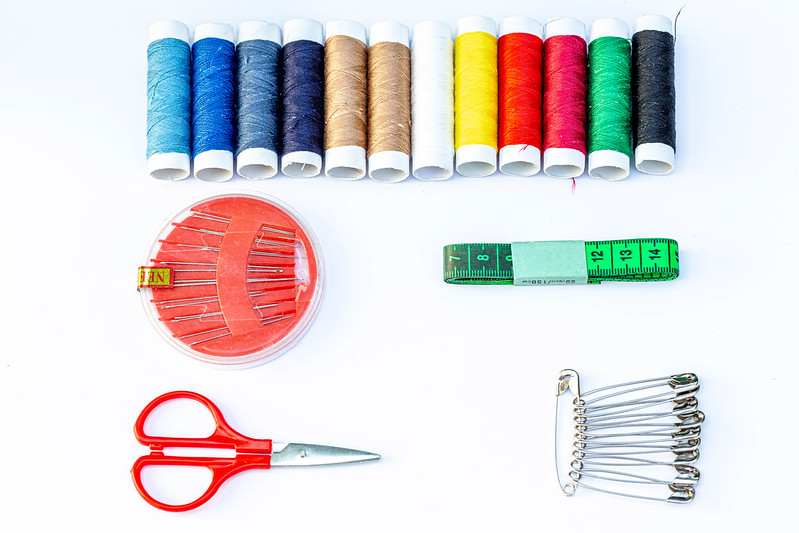Getting the Right Sewing Kit Bundle

The sewing kit bundle is a great way to get all the basic supplies you need for some easy and fun projects. You don’t want to waste valuable time trying to figure out what you need when you could be stitching, so let me help!
An assortment of needles in various sizes.
Needles are the most important part of any sewing kit. They come in different sizes and materials, such as steel, titanium or aluminum. They also come in a variety of lengths, which makes them suitable for different types of fabric and stitching techniques. Needle size is determined by their diameter; the lower the number, the larger it is. If you’re new to sewing or want to learn more about needles, check out our [Sewing 101] series!
In addition to needles for general sewing purposes, consider purchasing an assortment of specialty threads that can be used with specific projects such as quilting fabrics or denim trousers/jeans (denim). You’ll also need a good pair of scissors—try not to use kitchen shears because they’re not sharp enough for accurate cutting!
A case for storing your sewing needles.
To make the case, you’ll need:
- A piece of sturdy cardboard (you can use the back of an old cereal box)
- A stapler
- A ruler and a pencil or pen for marking your measurements
Then, follow these steps to create a place where you can store your needles:
- Measure and mark two lines on the cardboard that are 3/4″ apart. Make sure they’re parallel to each other and perpendicular with your ruler’s edge (i.e., at right angles).
- Measure and mark out six rectangles that are each 2 1/2″ long by 1″ tall—three on each line—and then cut them out using scissors or an X-ACTO knife (make sure not to cut off any fingers!). You should end up with 18 little rectangles total!
A small pair of scissors.
A small pair of scissors is essential for cutting thread and fabric. Small scissors are also useful for cutting small pieces of fabric, which can be difficult with larger ones.
You may be tempted to try using your large sewing scissors for these tasks, but keep in mind that they are harder to control than smaller ones and you risk damaging the fabric or cutting yourself if you aren’t careful. If you don’t have any small scissors handy, grab a pair of nail clippers and use those instead! The curved ends are perfect for clipping threads without snipping into them (a common problem when trying to cut with regular sewing needles).
For measuring hemlines, seam allowances and areas where you need to stitch pleats: Use your seam gauge!
Thimbles of various sizes.
Thimbles are a critical part of any sewing kit. They keep your fingers safe from getting pinched or pricked by the needle, and they reduce wear on the skin around your finger tips. Not only that, but thimbles can also be used for other crafting projects such as embroidery and beadwork!
There are many different types of thimbles available to choose from: metal, plastic and rubber. Metal ones tend to be more durable while being heavier in weight than either plastic or rubber ones. However metal can often feel uncomfortable when worn under clothing so make sure you try them on before purchasing if possible (ask someone else who owns some if they aren’t available locally).
A seam ripper.
A seam ripper is a tool that can remove stitches, seams, and the like. It’s typically very small with a pointy tip and often looks like a miniature pair of scissors. It’s also made from different materials—some are metal while others are plastic or wood.
The most common use for a seam ripper is to remove stitching mistakes when sewing by hand. If you’ve been following this guide along with me up until now, then you already know how useful they are! Just like your scissors can be used for more than cutting fabric (they’re also great at cutting paper), so too does your seam ripper provide additional uses beyond its main purpose of removing stitches:
- Remove buttons from clothing
- Remove hems on pants and skirts
Measuring tape.
A measuring tape is a must-have sewing kit item! It is not just used to measure. A measuring tape can also be used as a cutting guide, pinning and basting guide, or even as a straight line guide for stitching. To use it as a cutting guide:
- Place the end of your fabric along one edge of the measuring tape and wrap it around to meet up at the other side (you do not have to cut through both layers).
- Measure from one side to get your length measurement—this will be how long you cut your fabric piece with when using traditional cutting methods like straight edge scissors or rotary cutter blades (more on those later).
- If you’re using something that does not require you to cut through both layers such as pinking shears or bias tape maker (see below), then skip this step because both sides remain intact after trimming!To use it as a pinning or basting tool:1
Seam gauge.
You should always have a seam gauge with you when sewing. This tool is used to measure the seam allowance and make sure it is the correct size. A seam gauge can be made of plastic, metal or wood and usually measures 1/16″ (1cm) on one side and 1/8″ (3mm) on the other side. It’s often shaped like an inverted trapezoid with graduations printed on both sides of each triangle. Some gauges will have additional lines between those printed measurements to help you cut even more accurately into your fabric pieces.
Pins and safety pins in a variety of sizes.
Safety Pins: You can never have too many safety pins. They are useful for holding fabric together so you don’t have to sew right away, which could lead to mistakes. And they’re also good for just holding the fabric together when you do decide to start sewing. For example, if you want your shirtsleeves to be very long but not so long that they get in the way of your arms moving around and doing things, then safety pins are great for pinning up excess fabric, leaving only what’s needed free from the rest of it.
Pins: You should get a variety of different sized pins (not just straight or curved). These are used mainly with sewing machines but can also be helpful when hand stitching certain items such as buttons or zippers on jackets/coats etc., especially if there aren’t any other materials available nearby that would keep these things in place while working on them (e.g., needles might break off inside).
Straight pins with different colored heads for color coding your sewing project.
Straight pins are an essential item for any sewing kit. They come in handy when you need to hold fabric together, especially when you’re working with thinner fabrics or trying to keep a hem straight. The head of the pin is usually made from metal and can be removed by pushing it through the fabric and back out again to leave a hole in your garment. Safety pins don’t have this feature, so they’re best suited for thicker materials where tearing might be more likely than breaking through with a needle.
Safety pins are also great if you’re using lighter-weight materials because they’ll hold better than straight pins without much effort on your part! However, if you want something that’s easier to remove later on (such as after washing or drying), then stick with straight ones instead because safety ones tend not to come off easily once they’ve been put into place—and sometimes even tear holes into your clothes while doing so!
Knowing what you need in a beginner sewing kit will help you purchase the perfect set!
When you first start out with a sewing kit, it can be overwhelming to know what’s needed and what isn’t. There are many different tools and supplies that are used during the sewing process and the selection is vast. However, there are some essentials that every beginner should have in their kit. These items will help you learn how to sew properly and ensure your projects turn out great!
The best way to get started is by buying a sewing kit bundle with everything you need in one place. This way, you don’t have to worry about finding the right materials separately or having them shipped from different places at different times – everything will be together in one place so all your supplies stay organized and easy to reach when needed most!
Once again: A good starter kit needs more than just thread spools (though those certainly help!). It also includes other important tools like scissors for cutting fabrics into different shapes; chalk pencils for marking patterns onto fabric before cutting them out; measuring tapes for making sure everything fits properly before stitching anything together; pins along with needles made specifically for use on cloth surfaces (they’re different from those used on paper); rulers/measuring sticks & templates which come in handy when making certain types of clothing items like dresses or skirts because they allow us greater accuracy than just eyeballing measurements while holding up fabric against ourselves would provide alone.”
Conclusion
When you’re starting out in the world of sewing, it can be tricky to know what tools you need. But if you keep this list handy, it will make shopping so much easier! It’ll save time and money on buying things that don’t actually work well for your needs as well as save room in your home because they will fit nicely together without taking up much space at all.
--------------------------------
Guestposted.com Notice!
Audience discretion is needed, Read TOS.
Submit Guest Post / Read Latest / Category List
App & Rate-Us / Subscribe Daily Newsletter (FREE)



